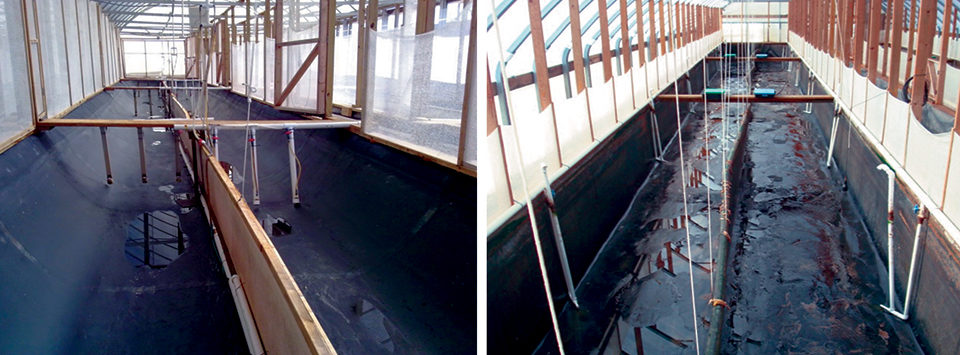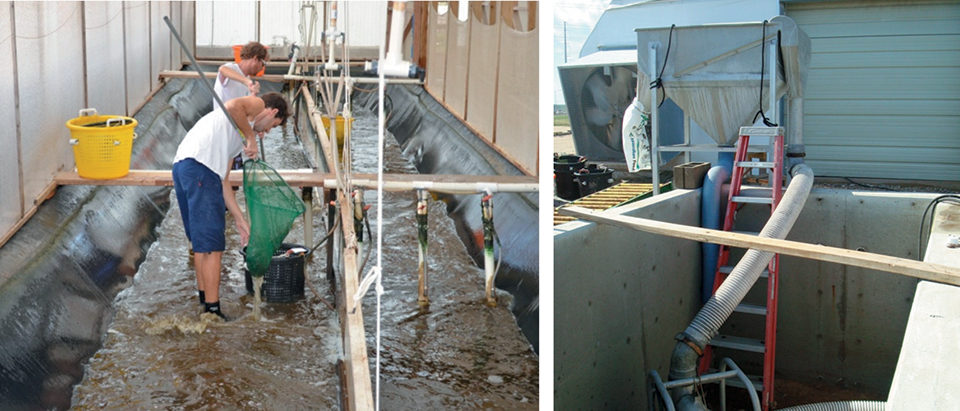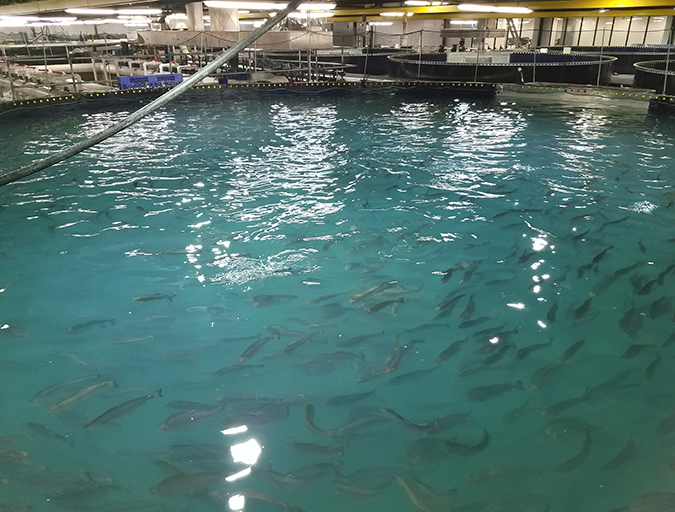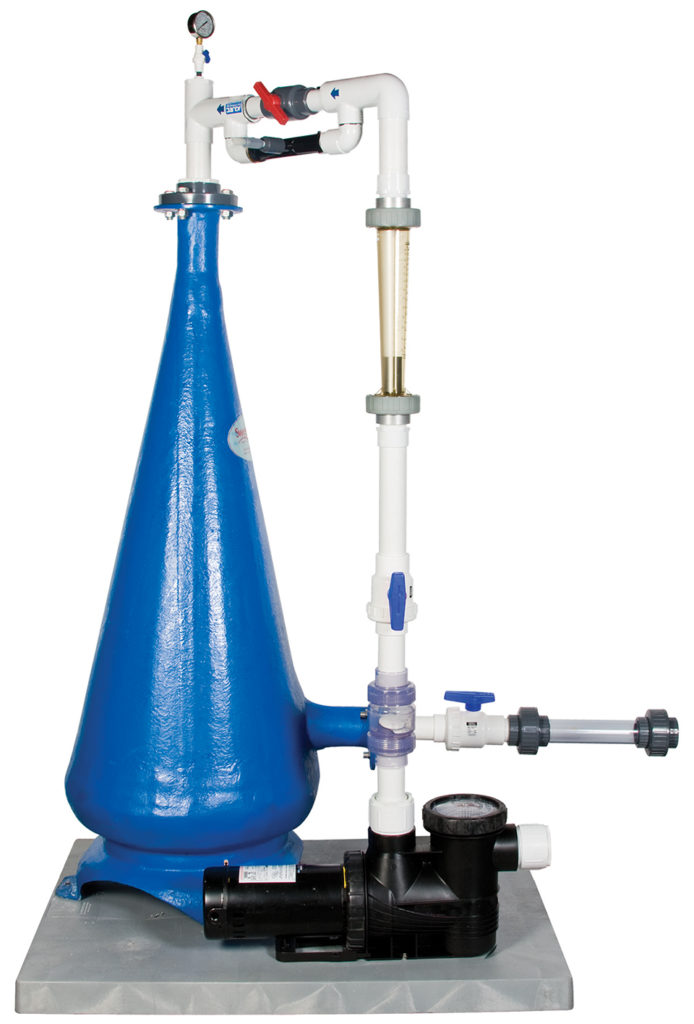Systems can be profitable, improve biosecurity and eliminate negative effluent impact

Recent advances in super-intensive, limited-discharge, biofloc-dominated systems for raising Litopenaeus vannamei suggest that these systems can be profitable when used to produce live or fresh, never frozen shrimp for niche markets. These systems offer improved biosecurity with reduced risk of crop losses to viral disease outbreaks. Furthermore, operating these systems with no water exchange minimizes the negative effluent impact on receiving waters.
Supported by the United States Marine Shrimp Farming Program (USMSFP), the authors have been working at the Texas AgriLife Mariculture Lab to improve the economic viability of super-intensive, zero-exchange systems for the production of food shrimp. Members of the USMSFP use economic modeling and other metrics to evaluate advances in management practices and culture systems used to produce market-size shrimp. Participating facilities have attempted to standardize factors such as salinity, stocking density, feed and postlarvae source to make more meaningful comparisons.
Two recent studies compared the performance of shrimp raised in AgriLife’s “old” 40-cubic-meter raceways and “new” 100-cubic-meter raceways, which utilize different methods of aeration and water mixing.
System descriptions
Previous studies by AgriLife researchers utilized a pump-driven Venturi to inject air and/or supplemental oxygen into a central manifold along the bottoms of the raceways to mix and aerate the water. The old system is comprised of six, 40-m3 , 3- x 28-m raceways inside a 32- x 26-m fiberglass greenhouse. A 2-hp pump and Venturi inject the culture water with atmospheric air or a mixture of oxygen and air. Additional circulation and mixing are provided by airlifts and air diffusers.
Small commercial foam fractionators control particulate matter and dissolved organics. This system has worked well for numerous studies in the past in producing 8-9 kg/m3 of marketable shrimp.
The new system consists of two, 100-m3 raceways (33 m x 3 m) inside a 40- x 9.5-m double-layered polyfilm greenhouse. To reduce operational costs by reducing energy use and eliminating the need for supplemental oxygen, a newly patented non-Venturi injector was installed to provide aeration, mixing and circulation. These injectors, currently used in several wastewater treatment facilities, require little maintenance compared to other aeration methods.
A total of 14 nozzles were positioned parallel to the direction of flow along the bottom of each raceway wall. In addition, one nozzle was used to power a home-made foam fractionator to remove particulate and dissolved organic matter. Two, 2-hp pumps are available to power the nozzles in each raceway. However, the entire system can be operated with just one pump when loading is low.
Both the old and new systems were equipped with dissolved-oxygen monitoring and alarm systems that uploaded data to a computer in the lab, which could also be accessed from remote locations. Real-time monitoring is a valuable management tool that helps to minimize stress, conserve resources and often divert what would otherwise become catastrophic events.

Trial 1: old system
In this study, each of four old raceways were filled with a mixture of 12 m3 of seawater, 8.5 m3 of biofloc-rich water previously used in a 42-day zero-exchange nursery trial and 19.5 m3 of municipal freshwater. The raceways were stocked at 500 shrimp/m3 with juvenile 1.9-g L. vannamei from a fast-growth line provided by the Oceanic Institute in Makapuu Point, Hawaii, USA. Salinity was 18 ppt in the four raceways.
For comparison, a fifth raceway was operated with water salinity of 30 ppt and stocked at the same rate with slightly smaller 1.4-g juveniles. Shrimp were fed a commercial 35 percent-crude protein feed specially formulated for intensive systems operated with limited water exchange. Feed was distributed by hand during the day and automatic feeders at night.
Water quality parameters were maintained within normal ranges for the culture of L. vannamei. Mean water temperature, pH and dissolved-oxygen concentrations were 29.4 degrees-C, 7.3 and 5.7 mg/L, respectively. Settleable solids were measured daily, while ammonia, nitrite, nitrate, alkalinity, turbidity and total solid suspended (TSS) were monitored at least once a week.
Shrimp were harvested using dip nets. Survival and feed conversion were similar between the 18- and 30-ppt treatments, while weekly growth was slightly better in the higher-salinity water, resulting in a higher yield (Table 1).
Samocha, Mean production values, Table 1
| System Volume | Density (shrimp/m3) | Salinty (ppt) | Initial Weight (g) | Final Weight (g) | Days | Growth (g/week) | Survival (%) | Yield (kg/m3) | Feed-Conversion Ratio |
|---|
System Volume | Density (shrimp/m3) | Salinty (ppt) | Initial Weight (g) | Final Weight (g) | Days | Growth (g/week) | Survival (%) | Yield (kg/m3) | Feed-Conversion Ratio |
|---|---|---|---|---|---|---|---|---|---|
| 40 m3 | 500* | 18 | 1.9 | 23.2 | 82 | 1.82 | 82.3 | 9.5 | 1.43 |
| 40 m3 | 500* | 30 | 1.4 | 25.1 | 85 | 1.95 | 78.9 | 9.9 | 1.44 |
| 100 m3 | 390** | 30 | 3.1 | 25.3 | 106 | 1.46 | 83.0 | 8.4 | 1.77 |
Table 1. Mean production values from growout studies with Litopenaeus vannamei in old and new raceways.
Trial 2: new system
The two new raceways were each filled to 100 m3 with a mixture of 55 m3 seawater, 10 m3 municipal chlorinated freshwater and 35 m3 biofloc-rich water from a previous nursery study. Taura-resistant, 3.14-g L. vannamei juveniles from Shrimp Improvement System in Islamorada, Florida, USA, were stocked at 390 shrimp/m3.
Shrimp were fed the same feed used in the other system. Feed was distributed by hand during the day and automatic belt feeders at night.
Water quality parameters were maintained within normal ranges, with a mean water temperature of 29.8 degrees-C, salinity at 28.5 ppt, 7.1 pH and 5.8 mg/L dissolved oxygen (D.O.). Settleable solids were measured daily. Ammonia, nitrite, nitrate, alkalinity, turbidity and TSS were monitored at least once a week. The system was operated with one, 2-hp pump until day 62, when D.O. levels began to drop below 4.5 mg/L, and the second 2-hp pump was started to provide additional aeration.
Shrimp were harvested from the harvest basin using a commercial harvest pump. At an average 83 percent, survival was good. Shrimp growth averaged 1.46 g/week, and mean final weights were 25.2 g. Feed-conversion ratios averaged 1.77, while the average yield obtained in this trial was 8.4 kg shrimp/m3.
Perspectives
The production figures from this year have been very encouraging (over 3,588 kg produced) and some valuable lessons were learned. The foam fractionators currently employed in both raceway systems were undersized, and some mortality was observed during periods of high solids combined with high temperatures and moderate D.O. levels. Simple, but effective, settling tanks were installed to control solids, and supplemental oxygen was provided until mortality tapered off.
During the initial 62 days of the production cycle, the aeration method used in the new 100-m3 raceway system was able to support 6.5 kg shrimp/m3 using one, 2-hp pump without an air blower. A preliminary economic analysis indicated that this system is more efficient in terms of energy and labor requirements than the previous Venturi-based system.
The trial in the older raceways demonstrated that the use of shrimp from a fast-growth line significantly reduced the length of the production cycle and would further reduce costs and increase the potential for more crops per year. In future trials, the authors hope to combine the use of fast-growing shrimp lines with the efficiency of the new raceways to achieve even better results.
(Editor’s Note: This article was originally published in the November/December 2012 print edition of the Global Aquaculture Advocate.)
Now that you've reached the end of the article ...
… please consider supporting GSA’s mission to advance responsible seafood practices through education, advocacy and third-party assurances. The Advocate aims to document the evolution of responsible seafood practices and share the expansive knowledge of our vast network of contributors.
By becoming a Global Seafood Alliance member, you’re ensuring that all of the pre-competitive work we do through member benefits, resources and events can continue. Individual membership costs just $50 a year.
Not a GSA member? Join us.
Authors
-
Tzachi M. Samocha, Ph.D.
Texas AgriLife Research Mariculture Laboratory at Flour Bluff
4301 Waldron Road
Corpus Christi, Texas 78418 USA -
Rodrigo Schveitzer
Marine Shrimp Laboratory
Department of Aquaculture
Universidade Federal de Santa Catarina
Florianópolis, Santa Catarina, Brazil -
Dariano Krummenauer
Institute of Oceanography
Universidade Federal do Rio Grande
Rio Grande, Rio Grande do Sul, Brazil -
Timothy C. Morris
Texas AgriLife Research MaricultureLaboratory at Flour Bluff
4301 Waldron Road
Corpus Christi, Texas 78418 USA
Tagged With
Related Posts

Health & Welfare
A holistic management approach to EMS
Early Mortality Syndrome has devastated farmed shrimp in Asia and Latin America. With better understanding of the pathogen and the development and improvement of novel strategies, shrimp farmers are now able to better manage the disease.

Intelligence
A land grab for salmon (and shrimp) in upstate New York
The operators of Hudson Valley Fish Farm see their inland locale as a pilot to prove that land-based fish farming, located in close proximity to major metropolitan markets, can be successful.

Responsibility
A look at unit processes in RAS systems
The ability to maintain adequate oxygen levels can be a limiting factor in carrying capacities for RAS. The amount of oxygen required is largely dictated by the feed rate and length of time waste solids remain within the systems.

Responsibility
A look at various intensive shrimp farming systems in Asia
The impact of diseases led some Asian shrimp farming countries to develop biofloc and recirculation aquaculture system (RAS) production technologies. Treating incoming water for culture operations and wastewater treatment are biosecurity measures for disease prevention and control.



